Newsletter
Spring 2013
No. 37
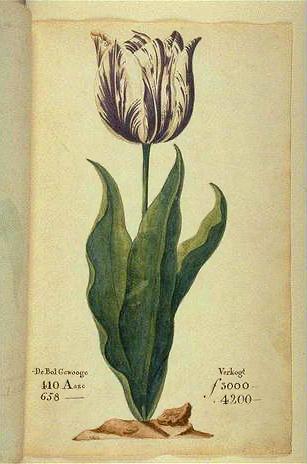
Newsletter |
 The Viceroy
|
How quickly the time flies and I find myself penning (or rather typing) another piece for the Newsletter. At present (late February) it is bitterly cold with an icy east wind but it is not raining so I am hoping it will dry the ground out a bit. Currently I am only venturing into the garden to feed the birds and unfortunately the squirrels, hang the washing out and read the thermometer in the greenhouse. Last weekend I was out there and ready for action but the soil was far too wet to walk on so I had to console myself by a bit of sweeping and tidying round the greenhouse. I washed all the glass inside and out so gave myself a pat on the back.
On the plant side, I have greenhouse staging full of small auriculas, some of which have flowered. Next month I will start feeding them and hope for many more flowers. My Sorbus koehneana seedlings grown from HPS seed are showing signs of activity, so many thanks to whoever donated it. My next task after I have finished this article will be to look at this year's HPS seed to work out a timetable for sowing and dust the propagators down ready for action.
Snow does have its uses as a thick layer on my greenhouse roof provided insulation from the worst of the cold. In the garden I noticed some flower heads poking through the snow and realised they were Iris reticulata ‘Katharine Hodgkin’. I might have missed them otherwise. At Hanbury Hall gardens, where I volunteer, we have tray loads of them in full flower and they are selling like hot cakes.
In the next few months, as you are gardening, please remember to keep any spare seedlings or divided plants for our Plant Sale in June as well as for our plant tables at our monthly meetings. Last year you donated a fabulous amount and we would love the same this year. We hope you are enjoying this year's programme of talks and looking forward to our coffee mornings and Cumbrian holiday.
Bearing in mind the (possibly) Chinese saying 'Be careful what you wish for: your wish may be granted' I shall refrain from ending this report with a wish for any kind of weather as I remember complaining about the dry conditions some time back and look what happened!
Happy gardening,
There is a sort of theme to this edition of the Newsletter, albeit entirely coincidental and not due to any editorial flair on my part, and it is that of ‘change’. I think most of us have a default position of not liking change, or at least being rather wary of it, but it can have good and often surprising results. This is particularly true in gardening, where in reality change is the default position as no garden can ever remain the same for long as nothing lives forever. It does us all good to experience from time to time something different, whether that is growing new plants, visiting other people’s gardens or volunteering to take part in events such as the Plant Sale. Not only is it enjoyable but it widens our experience and knowledge and hopefully spurs us on to try something new and not be afraid of change.
As both Bev and I have said at meetings, we need members to take on Committee roles in the future as several of the current Committee either have or by next year will have served at least three years and wish to step down.
I hope this article will give those of you thinking of volunteering for the Committee a clearer idea of what the Committee member roles are. There are usually three Committee meetings each year, in November, February and July. Obviously we contact each other in between Committee and Group meetings to discuss group business and take it forward. Committee members usually arrive early before the monthly meetings to set up the room and get the ball rolling.
John McGhee would like to step down as Treasurer as soon as possible and Bev Drewitt will finish her term of office as Chairman in March 2014. It is obviously important for the Group that someone takes on these roles.
Treasurer
The Treasurer ensures that money coming in and going out is handled correctly, does the banking, prepares the group accounts for the external examiner, and presents the accounts and a financial summary at the AGM. The Treasurer, Chairman and Secretary are signatories for group cheques. He also works with the Secretary to ensure we have correct membership records and records of attendance at meetings. John has set up systems to handle the Treasurer's work so his successor would have these to take the work forward.
Chairman
The Chairman leads the monthly meetings, giving the notices, introducing and thanking the speakers. He or she chairs the Annual General Meeting and Committee meetings. The Chairman is important, not just for these formal duties, but to help and advise other Committee members if asked or if he or she thinks it appropriate.
Other roles
Celia Guest (Programme Secretary), Lynda Niccolls (Publicity Officer) and Marilyn Wrightson (Speakers Secretary) also all finish their period of service next March.
Programme Secretary
The Programme Secretary makes sure we have a co-ordinated programme covering indoor meetings, coffee mornings, outings, garden parties, garden tours and any special events such as plant fairs, shows, national HPS days. To do this, he or she liaises with the Speakers Secretary and organisers of other events. He or she also organises up to three coffee mornings and one or two coach outings a year (or arranges for another member to do so). Celia has also been responsible for the raffle.
Speakers Secretary
The Speakers Secretary selects, books and liaises with speakers within a budget agreed by the Committee. He or she liaises with the Secretary to ensure the Hall is booked and with the Programme Secretary and Publicity Officer to ensure members and potential members have information about the subject of the talks and of the speakers. It will be helpful to have some method of recording speaker performance. Guidelines on the duties of the Speakers Secretary are contained in the List of Speakers issued by the HPS Administrator and Marilyn has a system in place.
Publicity Officer
The job of the Publicity Officer is to publicise and promote the HPS and Worcestershire Group using affordable local media and outlets and tapping into members' local knowledge of possibilities. It requires Internet access and computer literacy as regular email use is needed.
Lynda has been doing this for some time and so has a lot of information and tips she can pass on to anyone taking on the job.
I hope this information will mean that some of you consider seriously coming on to the Committee. We have had a very full and enjoyable programme for the last few years and hope that this can continue, albeit perhaps with changes reflecting group wishes. Some of you are very supportive of the Committee while not being on it, which everyone very much appreciates, but it does need a group to lead and co-ordinate our activities. I have more detailed written descriptions of the Programme Secretary, Speakers Secretary and Publicity Officer, so please come and talk to any member of the Committee if you feel you might be able to help.
During the HPS meeting in January, Duncan Coombs asked the question “How many gardeners like change?”.
This set up a chain of thought. During the severe winter of 2010-11, I lost trees, shrubs and perennials. This suddenly opened up the garden for new ideas, and what fun it has been. Yes, it can be costly, although with propagating shrubs, growing seeds, and exchanging plant divisions with friends, one can have rewarding experiences.
Having grown a black Cornus from a cutting, I am now puzzling where to grow it, especially as the plain green leaves are rather uninteresting.
During my gardening lifetime I have experienced very hot drought, severe cold and very wet, as well as animals visiting my garden and destroying plants. Nevertheless, enthusiasm remains, and new plants come along to tempt me into redesigning my beds, so, yes, change is very welcome.
In the winter gloom and wet just one plant can light up the garden, but walking through the garden on a bright winter’s day it is often scent that heralds their presence. There is nothing better than the sweet, spicy scent of wintersweet with its little waxy cream and maroon flowers. A star turn for visual impact is my Hamamelis, its golden flowers with their narrow twisted petals clustered along the bare branches making it a living sparkler. This year the flowers survived several days of heavy snow to emerge just as glorious as the snow melted.
However, once the flowers have faded, the plants themselves tend to fade from our thoughts. Most need very little pruning as they are slow growing, but they do benefit from feed and mulch in spring and it is a good time to look at the shape, and there are others that need a bit of judicious pruning.
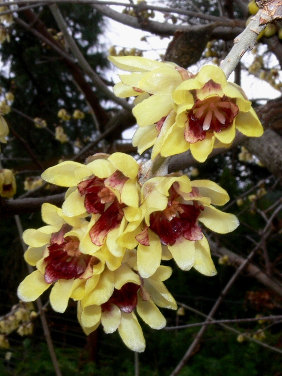
Hamamelis and Chimonanthus are both tidy shrubs, slow to mature and really need pruning only to maintain desired shape and size. Remove any dead wood, shorten untidy long growths and perhaps consider removing any particularly low branches to allow for underplanting.
Cornus mas, the Cornelian cherry, also needs only minimal care to keep an open shape. Overgrown specimens can be rejuvenated by cutting back to a framework of branches, cutting just above the new buds.
Daphnes are best left unpruned as they are very susceptible to die-back and various diseases.
There are a couple of thugs among this group of shrubs. One is the winter flowering honeysuckle, Lonicera fragrantissima. I have planted mine in the wrong place and may have to consider moving it as its new growth regularly makes it difficult to get to the greenhouse. It is an untidy shrub with vigorous new growth, but flowers on second-year wood so does require pruning in spring, cutting old and weak stems back to the base to encourage new growth. Prune all other shoots to shorten by about a third and maintain a balanced shape. Alternatively it can be hard pruned to a low framework.
I have included the corkscrew hazel, Corylus avellana ‘Contorta’, because it is most striking during winter when the twisted branches are revealed. It produces yellow catkins in late winter before the leaves emerge. The corkscrew branches are slow growing, but the extensive root system will sucker and may revert to strong straight growth spoiling the overall appearance. Any unwanted growth should be pruned to the ground.
Mahonias flower early; mine had finished flowering by Christmas this year. Mahonias can become large, but have a lovely architectural quality. Long stems can be shortened to a whorl of foliage or a side shoot after flowering, whilst old stems that have become bare at the base can be cut hard back.
Sarcococca confusa and S. hookeriana var. digyna (Christmas box or sweet box) are suckering shrubs. After flowering they need only light pruning to maintain shape, but in late winter it is necessary to remove suckers to avoid the plant colonising outside its allotted space. Don’t forget to pot up the suckers for a plant sale or swap!
Last year the Group held its first plant sale which took place on the morning of our June meeting. The membership rallied to the cause magnificently supplying an astonishing number of plants. Despite relatively poor attendance from the public at large, sales grossed £600 yielding a net contribution to funds of just over £500, a most creditable result. Equally importantly, everyone involved appeared to enjoy the experience and the Society raised its profile in the wider community. On the strength of this the Committee decided to hold another sale in 2013, and are confident that by addressing some of the shortcomings of the first sale last year’s result can be exceeded by a good margin.
As both large and small halls at Peopleton are now in regular use on Saturday mornings it has been agreed that the sale should be held on the afternoon of 8 June in place of our regular meeting. The talk will be re-scheduled to October where a cancellation has left a vacancy. It is hoped that as many members as possible will support the sale, either as helpers or buyers or both.
The doors will open to the public at 2 pm and close at 4 pm. The hall itself will be open from 12 noon to receive plants. Checking over, pricing and displaying the plants absorbs a lot of time and effort, and members are asked to arrive with plants early rather than at the last minute. Unsold plants should be taken home after the event. The strapline in our publicity will be lovingly grown by those who care. In other words, as Hardy Planters we are setting ourselves a standard to live up to and the emphasis must be on quality rather than rarity - good plants, nicely presented and labelled in clean, weed-free pots. Plants will be priced on arrival.
Please get in touch if you are unable to bring plants in person on the day. Kathryn Elrick-Smith in Worcester is able to act as a collection point and my yard, too, will be available. Linda Niccolls will be looking after publicity and she would welcome your support in getting flyers displayed and distributed throughout the area. Please let her know if you can help. To assist in planning a list of helpers will be available for you to sign at meetings between now and June. Last year we proved we could do it. Let’s go for the Gold this year!
Soon after our move to north Gloucestershire, over eight years ago, we took a close look around outside and found that we had inherited far too many trees for a small garden. A count produced a figure of 33 trees of varying sizes, plus three prostrate junipers. Taking into consideration that trees tend to grow very quickly, it was obvious to us that a cull was necessary if we were to make a garden. Over the next weeks and months we dug out the smaller 3-4ft trees ourselves, and engaged a local tree surgeon to deal with the rest, which included two very tall conifers. When this work was completed, we were left with a manageable 13 trees, namely: a beech, a fastigiate Irish yew – a useful guide to the wind direction, a delightful airy Swedish birch, two common silver birches, two Japanese acers - giving us lovely leaf colour in the autumn, a rowan, a holly, a yew – although more bush than tree, a venerable pear and an equally venerable apple – survivors of the time this area was covered with orchards, and, finally, a conifer of unknown variety, only retained because it hides our oil tank and flue.
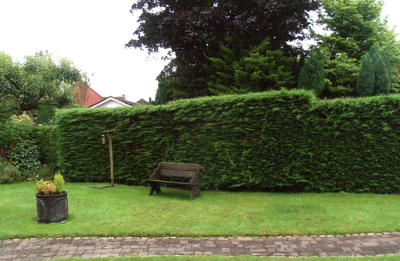
However, our original count had not taken into consideration a further 11 Leylandii conifers, which previous owners had cut and shaped to create a hedge, screening the front of the bungalow from the drive, shared with two other properties. It ran for some 44ft between the pear tree at one end and the yew at the other.
We had accepted it without question in the first place, because it was a part of the boundaries defining our land. We had it trimmed once, sometimes twice, a year, but, because Leylandii will not sprout from old wood, ultra-caution with the trimming led to it gradually increasing in size year on year. By the beginning of 2012 it had advanced over two feet into the drive and was more than seven feet high.
What really sealed its fate had occurred a year earlier when the conifer aphid, which is prevalent in the area, discovered us, and started creating unsightly brown patches. A call to the RHS Advisory Service at Wisley only produced the answer that there is nothing much you can do about it, as spraying is largely ineffectual. Where the hedge was concerned, procrastination was no longer acceptable – it was time to say Goodbye!
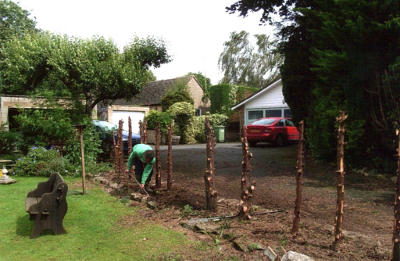
The next problem was what to put in its place. We rejected the idea of leaving the front open, considered a beech or hornbeam hedge, or a combination of both with the possible addition of hawthorn and yew, but decided it would be some years before reaching acceptable maturity and would need considerable maintenance. The only viable alternative was a fence. We obtained a catalogue from our local wood-yard at Weston sub Edge and spent some time mulling over the surprising variety of options available, from close boarding to fancy panels. In the end we chose 4ft high by 6ft wide panels with a woven effect, topped with 2ft high trellis panels.
In July our son-in-law, who has some experience in fencing, came up from Cornwall to carry out the work. Within three days the transformation was complete. The brushwood along with the Leylandii trunks and the majority of the roots were removed and taken away for burning. The posts, gravel boards, and seven panels, together with the trellis panels, were then put in place.
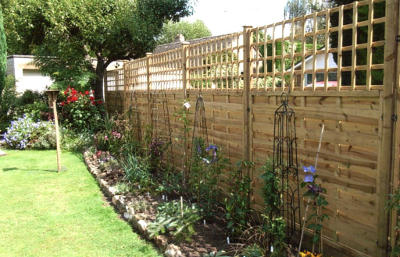
The drive was now two feet wider, making for easier access, and we had more light reaching the front of the bungalow. But for me, the biggest bonus was the 44ft long by about 4ft wide bed created by the demise of the hedge. As the soil looked thin and somewhat impoverished, I spread the contents of five bags of treated manure on the surface and then dug over the bed in preparation for planting. Without undue crowding I was able to accommodate 15 varieties of our favourite clematis, together with a mixed bag of hardy perennials in front of them. Daffodils and tulips were planted in any gaps. The final touch was to space out five decorative obelisks along the bed in order to break up the line of the fence.
We were more than pleased with the result. Even at this early stage it looked so much more attractive and interesting than the sombre dark green of the Leylandii. How the plants will fare after the never-ending rain and the winter weather remains to be seen, but we look forward with interest to the results of this alteration to the garden.
The Hardy Geranium Group are holding a Geranium Day at Avondale Nursery, near Coventry, on Saturday June 15th. Robin Moss will be talking about plants he has introduced and there will be geraniums for sale and for display/discussion. Worcestershire Group members are invited to join them at a cost of £5 for the day. For more details contact Oliver Folkard,1Baron’s Close, Fakenham, Norfolk, NR21 8BE.
For the first three summers the weather was kind to us and we were able to work and watch our garden develop and grow. The vegetable garden was fairly productive with garden peas, broad and French dwarf beans. There were runner beans, early and main crop potatoes, sweetcorn, courgette and marrow, but the main downfall was the lack of water. Our soil was very sandy, what rain we did have evaporated or leached away. Gradually the sandy soil has been incorporated with garden compost and liberal amounts of horse manure - a daily and much prized gift from our immediate neighbour.

Our next task was to build a course of stone steps to connect the house and the first part of the garden and a connecting path down to the greenhouses. This path runs alongside the ‘Great Wall of China’. The pathway is now known as Stable Walk. This high retaining wall keeps back the soil for the main herbaceous borders. I was very keen to get in the many plants we had brought with us and to have a bed of summer flowers. There were cuttings of phlox, delphiniums, lavenders, Phlomis russeliana and much more, backed up with colourful annuals, cosmos, Salviafarinacea ‘Victoria’ and perennials from seed. With the weather that year the displays were wonderful.
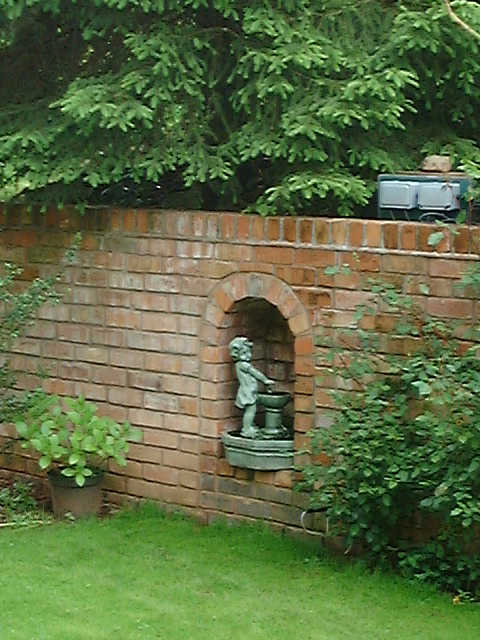
The next stage in our garden involved the area around the patio and the existing raised garden pool. The wooden supports around the edges and the wooden walling holding up the upper levels were badly rotted. Here we go again, another retaining wall to build. Our close friend in Eckington needed her 80 year old piggery dismantled, so we did. The new wall was to be built from them. Chris hired a lorry and all the bricks were shipped off to The Lodge. After cleaning and scrubbing each brick and with worn down finger nails a beautiful wall emerged. A double skinned wall was erected and as a feature an arch was built into it. ‘Gertie’, a small but quaint fountain, was seated into the recessed arch.
Having noticed that there were a couple of rhododendrons growing happily among other acid loving plants, we decided to create an Acer Meadow and planted three lovely species. All were birthday presents. Later, additional acers were added. Acer davidii and Acer capillipes raised from seed. The source of this seed was part of the RHS seed distribution service to members. As part of the ‘meadow’ theme, corncockles were sown along with Primula veris and Primula vulgaris. The corms of Fritillaria meleagris and F. verticillata were planted in a drift down the slope. Some years the pretty flower heads are attacked by passing pheasant but despite this they have slowly increased their numbers. Perhaps I could manage to buy a few more corms but it would have to be at the expense of other planting material.
We turned our attention to the upper level of the patio. After dismantling the raised pool, we, that is, I, still needed a garden pool. To see the reflection of trees and plants and the blue sky in an expanse of water greatly appealed. Chris excavated a vast amount of spoil from the chosen site; there was so much that you would have thought that it was to be a lake! The soil and rubble were carted off to be deposited on the left hand side of the ‘Tractor Shed’ - a very tedious and exacting task. We also excavated an upper pool to feed the lower, via a cascading waterfall. Later, a bridge was added to this, a wonderful bridge known as ‘The Gidleigh Bridge’ leading to ‘Long Walk’ and the Summer House.
To be continued …
Our December speaker, Fiona Grant, set me off thinking that a visit to Croome Walled Gardens, currently being restored, might be of interest to some of you. The Gardens are not part of the National Trust's Croome Park Estate and are open only to groups. Chris Cronin, who is leading the restoration, would be very happy to show us round the Gardens on the morning of Wednesday 24 July.
The earliest plan for the gardens, from 1750, maps over 7 acres, and the records, which are almost entire, show continuous cultivation into the 20th century. The restoration began in 2000 with the garden virtually overgrown. The Melon and Fig House were restored early on, but it took a long time to restore and rebuild the walls, drains and, now, the Dipping Pond. Today there are also a rose garden, vegetable beds, and fruit growing on the walls. The website shows progress.
As the gardens are local, we can use our own cars. Chris has an arrangement with the National Trust that his visitors can use their car park at Croome Park (WR8 9DW) and meet him outside their reception building. So he will meet us there at 10.30, and take us down to the gardens, a five-minute stroll away. (If anyone who wants to come has difficulty with the walking, he can organise a space at the gardens.)
He will take us round the gardens on a 'walk and talk' tour which lasts between an hour and an hour and a half, and then provide tea, coffee and biscuits or cake. There is no charge, but donations are very welcome.
If, like me, you like walled gardens, this should be a fascinating morning.
The limit on numbers in a group is 30. Would anyone who would like to come please let me know by 13 July. There is a list on the Secretary's table.
You may be interested to learn that I had a phone call from a member of Herefordshire and Mid Wales Group about the newsletter. She had seen my piece on my Dutch trip (Autumn 2012 Newsletter), thought it sounded exactly what she and her husband were looking for and wanted details of the company. Our fame is spreading!
So please do keep sending in your contributions - Kathryn